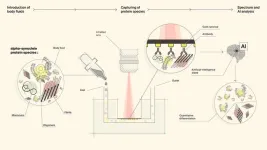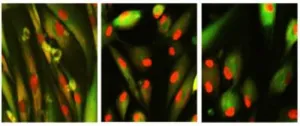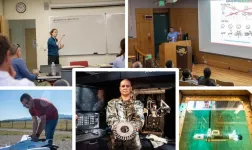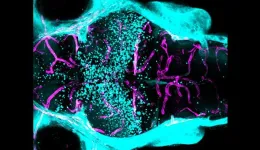Secrets of Egyptian painters revealed by chemistry
2023-07-12
(Press-News.org)
Within the scope of a vast research program undertaken in coordination with the Egyptian Ministry of Antiquities and the University of Liège, an international team—including scientists from the CNRS, Sorbonne University, and Université Grenoble Alpes—has revealed the artistic license exercised in two ancient Egyptian funerary paintings (dating to ~1,400 and ~1,200 BCE, respectively), as evident in newly discovered details invisible to the naked eye. Their findings are published in PLOS ONE (12 July).
The language of ancient Egypt has no known word for ‘art’. Its civilization is often perceived as having been extremely formal in its creative expression, the works completed by the painters of its funerary chapels being no exception.
Yet an international, multidisciplinary team1 led by CNRS researchers Philippe Martinez and Philippe Walter has brought to light pictorial techniques and practices whose faint traces had long allowed them to elude detection. While studying the likeness of Ramses II in the tomb of Nakhtamon2 and the paintings of Menna’s3 tomb—among hundreds of other nobles’ tombs in Luxor—they found signs of touch-ups made to the paintings in the course of their production.
For example, the headdress, necklace, and sceptre in the image of Ramses II were substantially reworked, though this is invisible to the naked eye. And in a scene of adoration depicted in Menna’s tomb, the position and colour of an arm were modified. The pigments used to represent skin colour differ from those first applied, resulting in subtle changes whose purpose still remains uncertain. Thus, these painters, or ‘draughtsmen-scribes’—at the request of the individuals who commissioned their works, or at the initiative of the artists themselves as their own vision of the works changed—could add their personal touches to conventional motifs.
The scientists relied on novel, portable tools enabling nondestructive in situ chemical analysis and imaging to make their discovery. Altered by time and physicochemical changes, the colours in these paintings have lost their original appearance. But the chemical analysis performed by the scientists, together with their 3D digital reconstructions of the works using photogrammetry and macrophotography, should make it possible to restore the original hues—and change our perception of these masterpieces, too often viewed as static artefacts.
The team’s research demonstrates that pharaonic art and the conditions of its production were certainly more dynamic and complex than once thought. The next mission of the scientists will be to analyse other paintings in the search for new signs of the craftsmanship and intellectual identities of ancient Egyptian draughtsmen-scribes.
Notes
The team in France is based at the Laboratory of Molecular and Structural Archaeology (CNRS/Sorbonne University) and the Institut Néel (CNRS). Its work is part of an ambitious program coordinated with the Egyptian Ministry of Antiquities and the University of Liège.
Nakhtamon was a priest responsible for the daily provisioning of altars in the Ramesseum, or ‘House of Millions of Years’, of Ramses II.
Menna held the title of Overseer of the Fields of the Lord of the Two Lands (i.e., Upper and Lower Egypt) and was responsible for their agricultural production. END
[Attachments] See images for this press release:

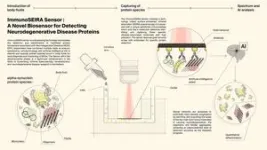
ELSE PRESS RELEASES FROM THIS DATE:
2023-07-12
By combining multiple advanced technologies into a single system, EPFL researchers have made a significant step forward in diagnosing neurodegenerative diseases (NDDs) such as Parkinson's disease (PD) and Alzheimer's disease (AD). This novel device is known as the ImmunoSEIRA sensor, a biosensing technology that enables the detection and identification of misfolded protein biomarkers associated with NDDs. The research, published today in Science Advances, also harnesses the power of artificial intelligence (AI) by employing neural networks to quantify disease ...
2023-07-12
Schistosomiasis, a parasitic disease that causes organ damage and death, affected more than 250 million people worldwide in 2021, according to the World Health Organization.
One of the world’s most burdensome neglected tropical diseases, schistosomiasis occurs when worms are transmitted from freshwater snails to humans. The snails thrive in water with plants and algae that proliferate in areas of agricultural runoff containing fertilizer. People become infected during routine activities in infested water.
Researchers from the University of Notre Dame, in a study recently published in Nature, found that removing invasive vegetation at water access points in and around several ...
2023-07-12
Since the International Organisation of Vine and Wine (OIV) approved the use of ultrasound to promote the extraction of grape compounds back in 2019, its application for obtaining superior red wines has been studied extensively.
Now researchers are turning their attention to rosé – an expanding market which has seen strong growth over the past 15 years. A team from the University of Castilla-La Mancha and the University of Murcia in Spain used high-power ultrasound technology to treat Monastrell crushed grapes – a process known as sonication ...
2023-07-12
On July 12, 2023, a new research paper was published in Aging, titled, “Chemically induced reprogramming to reverse cellular aging.”
BUFFALO, NY- July 12, 2023 – In a groundbreaking study, researchers have unlocked a new frontier in the fight against aging and age-related diseases. The study, conducted by a team of scientists at Harvard Medical School, has published the first chemical approach to reprogram cells to a younger state. Previously, this was only achievable using a powerful gene ...
2023-07-12
The Naval Innovation Center (NIC) at the Naval Postgraduate School (NPS) in Monterey, Calif., is part of the Secretary of the Navy’s initiative to leverage the power of American innovation for national security. Integral to the function of the NIC is the Naval Innovation Exchange (NIX), a new program that organizes and empowers multidisciplinary teams of NPS students and faculty focused on developing prototype research solutions.
While in its early stages, the NIC at NPS will leverage and empower ...
2023-07-12
At a glance:
Working with mice and zebrafish, researchers identify a gene, expressed in neurons, that produces a signal needed for development and maintenance of the blood-brain barrier.
When mutated, the gene makes certain regions of the blood-brain barrier more permeable.
The findings could help scientists control the blood-brain barrier — important for delivering drugs into the central nervous system or countering damage from neurodegenerative disease
What makes the vital layer of protective cells around the brain and spinal cord — ...
2023-07-12
Psychedelic-based therapies are poised to change the treatments that psychiatrists can offer patients.
“I often talk about psychedelic treatments as catalysts for change, for both the individual and the field of psychiatry,” said Medical University of South Carolina psychiatrist Jennifer Jones, M.D., who conducts research on these treatments.
The highly anticipated approval of MDMA, or “ecstasy,” to treat post-traumatic stress disorder would be the first for a psychedelic drug, ushering in changes for patients, mental health providers and society. The Food and Drug Administration is expected to issue a decision on MDMA-assisted ...
2023-07-12
Cancer therapies that target specific genetic abnormalities in tumors have revolutionized treatment possibilities over the past two decades. While quality of life and survival are improved with targeted therapies, relapse is common due to the evolution of new tumor cells that are resistant to the targeted therapy. A new study by investigators from the Mass General Cancer Center, a member of the Mass General Brigham healthcare system, reveals how lung tumors may develop drug resistance over time, pointing to a protein, called APOBEC3A, that could be a promising target. Results, published in Nature, may help researchers develop new ...
2023-07-12
NEW YORK, NY-- A new study suggests that eye drops developed by Columbia University researchers could be a more effective–and comfortable–therapy for a common eye disease currently treated with injections into the eye.
Retinal vein occlusion (RVO), an eye disease that affects up to 2% of people over age 40, occurs when a vein in the eye’s retina becomes blocked, leading to swelling in the eye, inflammation, damage to the retina, and vision loss.
Standard therapy involves injecting into the eye a vascular endothelial growth factor inhibitor (anti-VEGF) that reduces swelling. ...
2023-07-12
Scientists at the University of Texas Institute for Geophysics (UTIG) have developed a radar technique that lets them image hidden features within the upper few feet of ice sheets. The researchers behind the technique said that it can be used to investigate melting glaciers on Earth as well as detect potentially habitable environments on Jupiter’s moon Europa.
The near-surface layers of ice sheets are difficult to study with airborne or satellite ice-penetrating radar because much of what’s scientifically important happens too close to the surface to be accurately imaged. ...
LAST 30 PRESS RELEASES:
[Press-News.org] Secrets of Egyptian painters revealed by chemistry


